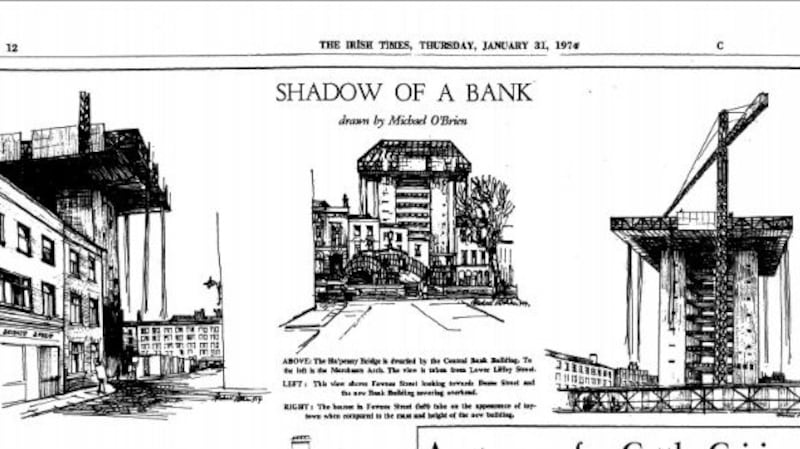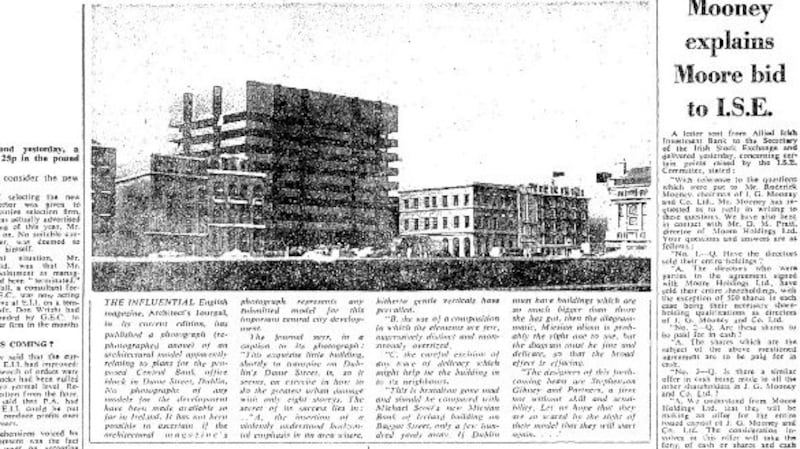[ added to Dublin city's list of protected structuresOpens in new window ]
On November 7th, 1967, a planning application notice appeared in The Irish Times. The Central Bank of Ireland wanted permission to build an office building (including vaults) on the sites of the Georgian Commercial Buildings at 42-45 Dame Street, 17-23 Fownes Street and 17-18 Cope Street.
The proposal was controversial from the outset. On February 14th, 1968, a letter to the editor pointed out how the recent Irish Georgian Society Bulletin contained “disturbing information that an attempt is being made to destroy the fine 18th century classical building which stands in Dame Street and to erect a 15-storey office block on the site”.
The writer, John Gilmartin, warned that if the plans proceeded “yet another important 18th-century building will disappear,” and added that the Edmund Peakes designed Commercial Buildings, with its finely proportioned classical façade, its graceful interior and delightful internal courtyard, “is as worthy of preservation as the Tailors’ Hall and Mountjoy Square”.
Nonetheless, planning permission was approved the following November for a modified 13-storey Central Bank building in Dame Street.
That decision was appealed successfully by An Taisce in 1969. The organisation convinced then minister for local government, Fianna Fáil’s Kevin Boland, that the proposed building would obtrude excessively on the skyline, would be out of scale with existing development and would detract from the “environmental quality” of College Green.
A subsequent application for a 120-foot, eight-storey building was accepted in 1969 and no appeals followed. The Commercial Buildings was pulled down in 1971 and construction began the following year on the new Central Bank building.

In September 1972 The Irish Times carried an extract from the English magazine Architects Journal, which published a photograph of a model of the proposed bank (which at that time had not been made available in Ireland). The journal described the proposed building as “an exercise in how to do the greatest urban damage with only eight stories”. It berated the “aggressively distinct and monstrously oversized” development which it described as “brutalism gone mad”.
The Journal went on to say “the designers of this forthcoming beast are Stephenson Gibney and Partners, a firm not without skill and sensibility. Let us hope that they are so scared by the sight of their model that they will start again”.
The greatest controversy arose the following year when it transpired that the building had risen about 30 feet higher than it was supposed to under planning permission, prompting Dublin Corporation to tell the Central Bank that their new 150 foot skyscraper was “illegal”.

The architects lodged an application for retention, the bank claimed it was unaware the building had exceeded the height limit, and construction work continued on the regardless. An Irish Times report from November 22nd, 1973, was headlined: "Work continues on bank building - Corporation ban ignored".
The application for retention was turned down by the Corporation, leaving the bank with two options: appeal to the minister for local government to overrule the decision or shave about 30 feet off the top of the building (at a cost of about £1.3 million).
They opted for the former and, after considering submissions delivered over the course of a three-day oral hearing, the then minister, Labour’s James Tully, overruled the corporation and granted qualified permission for completion of the building.
The decision angered many councillors who, according to a February 12th, 1975, report, said Tully had given permission for a building quite separate from the plans before him.
Construction continued and the new Central Bank building was finished in 1979 (notwithstanding a four-week strike by builders in 1978 over “the appalling squalor of conditions and bad wages of all building workers”.)
The following year a notice appeared in The Irish Times, reading: "With effect from Monday, 10th March 1980, all banking functions carried out at our Foster Place premises have been transferred to our Head Office in Dame Street."



















